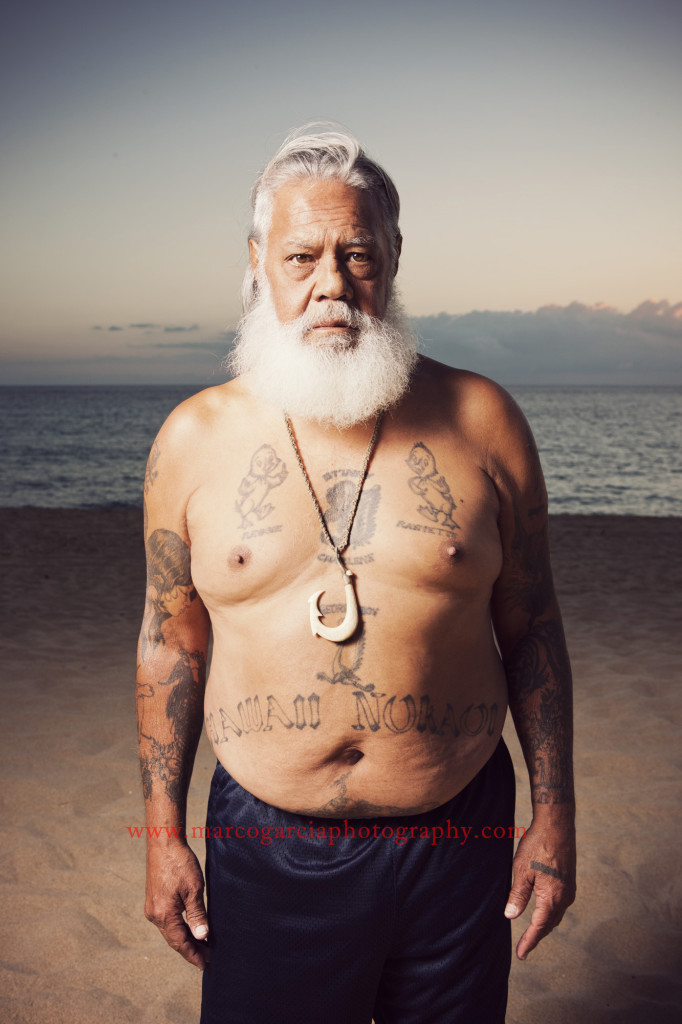
This past September, Hyphen Magazine, an Asian-American publication out of California, called me out of the blue and asked me to do a portrait of an ex con who was on Oahu. The story focused on Native Hawaiians who were incarcerated and sent off-Island to serve their sentences due to State budget matters. The ex con was one of the first Native Hawaiians to be shipped off in the late 1970s. After finding out how much they actually wanted to pay, I turned them down stating it was way too much work for what they expected. The photo editor, Damien Maloney, who believed I would be the best candidate to capture this unique portrait, then told me the story of Delbert Wakinekona and I was sold.
Its not everyday you get to spend time with a man who broke out of Folsom Prison, the jail made famous by the man in black, Johnny Cash.
According to a legal record found on the web, in 1970, Wakinekona and a partner entered a local store to buy sashimi when the outing turned deadly as the shop owners were robbed and beaten with one later dying of his injuries. Wakinekona and his partner were “indicted for the crimes of first degree murder, first degree robbery (two counts) and aggravated assault.” Although he claims he was not part of the attempted robbery and/or the beating was unintentional, Wakinekona was given a life sentence for the murder. Wakinekona felt he was framed by the others testimony and flawed court system worked against him. He tried unsuccessfully to fight his conviction but lost.
After serving time in jail, and if I’m not mistaken, breaking out of the Halawa Correctional Center, Wakinekona was found to be a troublemaker and was sent off-Island to the mainland to serve the rest of his sentence. Wakinekona was part of the first wave of Hawaiian shipped off to the mainland thus breaking his family and cultural ties to Hawaii. He sued to remain in Hawaii, even having his case argued in the US Supreme Court, but eventually lost his case.
And I ain’t seen the sunshine,
Since, I don’t know when
So as I drove out to Waianae to meet Delbert Wakinekona and Lilian Harwood, his new wife who helped him get out of prison on a compassionate release due to Delbert’s declining health, I filled with dread and anticipation of dealing with a man who might be maladjusted to the outside world. But the few hours I spent with ex-con Delbert had me understand not just what life is like inside prison but understood was prison does to a man. I make no excuses for the crimes Delbert supposedly committed. He was no angel. However time does change people and injustice can make a person very bitter.
Delbert, who looks give him the appearance of a weathered Santa Claus, greeted me with a smile but his demeanor made me realize he was a tiger. He looked through me, intimidated me, and outplayed me instantly. I immediately knew I was dealing with someone who understood the nature of man and survival. Delbert lived within a silent world where life and death were separated by a glance, a sudden mood change, a split decision. There was no trust, no basis of friendship or loyalty in his mannerism. He was dangerous. But dangerous as a means of survival.
We began to chat, talk and getting to know each other. I felt every move I made was watched and anticipated. Like a wild dog, any movements towards him might have resulted in a snap, growl or worse. I could sense he struggled with PTSD as he had been in jail for most of his life. The outside world was different. He had no constraints yet knew no other way.
I’m stuck in Folsom Prison,
And time keeps draggin’ on,
We talked about his case. He asked about my ethnicity. I told him I was Hispanic and he relished time time spent with Mexican Americans in Folsom Prison. He told me once he was shipped off Hawaii, he entered a world in the late 70’s early 80’s where Hawaiians were only known through Elvis and aloha shirts. Hawaiians were virtually unknown on the mainland and invisible in prisons. He was neither white or black so the only people he could visually associate with were the Hispanics. In his first encounter with Hispanics in jail, they began to talk Spanish which he couldn’t understand. The Mexicans, finding his disrespect intriguing, demanded to know who or what he was. He told them he was Hawaiian and quickly the Hispanics found humor in calling him a pina, or pineapple in Spanish. According to Delbert, this slight was more sexual in nature and he quickly had to establish he was no “fruit” and quickly gained the respect of the Hispanics for his bold stance. Delbert was then referred to as Hawaiiano which he claims with pride.
He talked about his case, his life, his breakout of several jails including Folsom, and life being outside. He talked about some of the more infamous inmates he knew at Folsom including Charles Manson and others. He talked of legal battles with prison wardens, judges, and prison itself. He talked of life on the lam and shining the light on Native Hawaiian struggle as they are sent off Island. He mentioned the correspondence from other infamous prisoners he met along the way. Delbert was a walking history book of American crime figures and prisons.
But that train keeps a-rollin’,
On down to San Antone
As I finally felt he trusted me enough to pose, we went down to the beach near Yokohama Bay at sunset and I was able to snap some haunting images of this man who some might feel he still belongs in prison for the crimes he committed. It wasn’t hard to have him give me that prison stare as it seemed natural to him. I never posed him pretentiously or expected him to show me some deep emotion. I wanted to capture him like the man I saw in front of me.
At first he work a dark blue t-shirt with some type of fishing logo and I really wanted it to come off. I quickly realized his body was covered in “jail-house tats” and Delbert was more than willing to show me his history told on the folds of his now old skin. He had the names of his children, Hawaiian folklore icons, dragons, roses, and a half goat man hugging a naked woman. His crude tattoos told a story that no hipster skin could ever begin to tell. These were the stories of a man whose life turn a turn for the worst on a faraway night back in 1970.
Across his now flabby belly were the words “Hawaii No Ka Oi’,” or simply, “Hawaii…the best.”
Aside from the convicted murderer who stood in front of my lens, I found Delbert to be a tiger, but an older tiger who still had his teeth but losing his bite. He was granted a compassionate release from jail as he is currently suffering from advanced liver cancer. Whether a man like this deserves to be out of prison is up to debate but with cancer quickly advancing, he might not be around long enough to fight that battle.
At the end, Delbert was grateful for the attention and kindness I gave him and gave me a bear hug that clearly wasn’t toothless. It was kind and tender but quickly felt the power of man who survived prison life. I learned I wasn’t meant for prison but a young Delbert probably thought the same thing. We all have tigers inside of us, its just odd we have to be incarcerated to find it.
When I hear that whistle blowin’,
I hang my head and cry.


